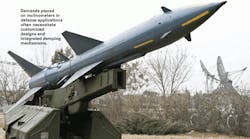A servo inclinometer is a highly sensitive transducer that converts a tilt angle into an electronic signal, and then precisely determines horizontal and vertical slope.
In short, within the inclinometer, a pendulum with unbalanced mass aligns itself with the Earth's gravitational field; pendulum deflection is proportional to the sine of the tilt angle.
Typically, the pendulus mass is mounted on a flexure-suspended coil that rotates within a magnetic field provided by a permanent magnet — similar to that employed in a dc motor. Then an electronic proximity sensor detects the position of the pendulus mass and the resulting error signal is used to feed current back into the moving coil, thereby restoring the pendulus mass to its original position.
The restoring current is itself the analog signal of the sine of the tilt angle.
For applications requiring precision and repeatability greater than that of conventional open-loop inclinometers, closed-loop, torque-balanced servo systems deliver resolutions to 0.1 arc second (0.00003°). These servo inclinometers are robust enough to maintain precision even after withstanding severe mechanical shock and vibration.
Over the years, inertial inclinometer technology has remained largely unchanged. However, increasingly compact designs and harsh conditions are spurring new levels of customization.
Damping methods
Some newer inclinometers incorporate fluid damping and mechanical stops. Fluid damping employs a specialized viscous fluid that encapsulates the mechanical servomechanism for shock protection and acts as an additional filter — attenuating unwanted background vibration to boost output-signal accuracy.
Fluid-damped servo systems are typically used in extreme applications; some protect against mechanical shock to 1,500 g.
Mechanical stops are used in inclinometers (and accelerometers) to prevent damage when these devices are exposed to acceleration exceeding their calibrated operating range.
Electronic damping is also used with inclinometers: Here, active low-pass output filters maximize the inclinometer's useable frequency range if critically damped. Alternatively, response can be overdamped to further attenuate the effects of environmental vibration and shock on the signal output. In environments with background electromagnetic interference, additional filtering ensures reliability and electromagnetic compatibility.
Typical applications: Military
The use of sensors in American designs, particularly for military applications, has exploded in recent years; this includes a resurgence in the use of mature technologies (such as inclinometers) to solve new technological challenges.
Case in point: The U.S. military Helicopter Alert and Threat Termination — Acoustic (HAALT-A) project includes commercial sensors reconfigured onto a helicopter airframe to acoustically detect incoming fire and localize shooters. Utilizing established sensor designs speeds development and deployment.
Miniaturization of designs in military applications is increasingly important as well, to meet efficiency, weight, and portability objectives. Here, inclinometers have been used as more cost-effective sensing options than those requiring development, testing, and fielding.
More specifically, sensors employed in defense applications are often used for situational awareness — to provide military personnel with information about present circumstances, to help enact the most appropriate actions. As a result, the volume of information being made available to military personnel has increased significantly.
-
Weapon-aiming mechanisms use inclinometers, as the sensors can deliver precise measurements even after exposure to severe firing-related mechanical shock — surviving many years of service in harsh environments.
-
Naval ship communications use inclinometers for antenna alignment on satellites. Here, precise total error bands in two axes are achieved over widely varying temperatures by thermally compensating the sensors' outputs at specific temperatures. Precise, robust, and environmentally protected sensors are required to withstand the rigors of these applications.
-
Military vehicles include mobile communication and weapons guidance-system levels that employ inclinometers. Such vehicles must be accurately levelled when stationary to ensure that their onboard systems are correctly referenced. Inclinometers also withstand transits over rough terrain.
For more information, call (877) 486-1766 or visit sherbornesensors.com.
